
Questions about the safety of a luxury hotel’s new dining concept involving bubble pods were raised amid experts’ advice to dine outdoors to minimize the risk of catching the coronavirus disease.
Sheraton Manila Hotel last Saturday introduced what they call the “Philippines’ first bubble dining pods.”
The concept, called the “Vubble Pod” or “Vubble” following the hotel’s Vega Pool and the word “bubble,” allows the diners to eat with their companions or family members without the anxiety of potentially catching the virus from other guests.
Through this, patrons can dine outdoors but inside pods to supposedly keep themselves safe and distanced from other diners while they remove their masks when eating.
It also offers a 360-degree view of the hotel’s outdoor pool and garden.
Aside from that, guests can partake in a “specially curated five-course meal” or enjoy recreational activities inside the pod. They can get a relaxing massage or let their kids play within the safe confines of the area.
Each of the six pods is airconditioned and ventilated at the top to supposedly ensure the guests’ safety. They are also UV, water and moisture-proof as well.
Stephen Reilly, chief operating officer of Resorts World Manila, said that the pods are also constantly sanitized in compliance with the prescribed protocols to reduce the risk of COVID-19 transmission.
“Hilton and Sheraton are actually running these vubbles for us, of course they have their international standards. So that’s something that the general public should not worry about. They’re sanitized and kept clean,” he told CNN Philippines.
Clients interested to book a pod would have to undergo the hotel’s mandatory health check which includes a forehead thermometer scan.
They are then ushered to the pods where they can dine or enjoy being outdoors while keeping distance from others.
The new dining concept raised questions from some Filipinos who pointed out the issue of dining within spaces in comparison to fully dining outdoors where the risk of catching the virus is reduced due to the wide air space.
“Personally, better to eat at home and get great food delivered. However, WHY HAVE A BUBBLE FOR OUTSIDE DINING? When eating outside, it is best to be in open air with social distancing and reduced capacity. NO LARGE GROUP DINING,” UP statistics professor Dr. Peter Cayton said in response to the report.
“Uhm bakit po ganito? ‘Di ba safer ang outdoors? The rich really wanna stay in their bubble no,” another Twitter user commented.
“Isn’t…open air dining safer…?” a different online user likewise asked.
“The hotel wants to trap the virus and for it to linger inside the enclosure and infect everyone inside? It’s already outdoors, the enclosure is not needed and makes it even more dangerous,” commented another Filipino.
Dining risks
In a report published by The Conversation, four health experts from the United States shared that they would not be willing to participate in indoor dining or eating in restaurants indoors due to the risks posed by COVID-19.
“The greatest risk of getting infected with SARS-CoV-2 is being indoors with people who aren’t using masks at all times. The concern isn’t just big respiratory droplets when close to someone talking; it’s also the tiny aerosols that linger in the air,” Dr. Thomas Russo from the University at Buffalo’s Jacobs School of Medicine and Biomedical Sciences, said.
“Some interesting studies have looked at the airflow and air currents in restaurants in relation to where people became infected. In one, a person was 20 feet away from the source for only about 5 minutes, but the person was directly in the airflow and became infected,” Russo added, with the report providing links.
Kathleen Brown, associate professor of practice and MPH program director at the University of Tennessee’s College of Education, Health, and Human Sciences, said that the US’ Centers for Disease Control and Prevention have reported patients testing positive were twice as likely to have eaten in a restaurant.
“In a restaurant, I am not able to assess the risk posed by other patrons or the staff. Each person in that restaurant has a network of others that, taken together, increases my risk of contracting COVID-19,” she said.
RELATED: Would you eat indoors at a restaurant? We asked five health experts
Health Undersecretary Maria Rosario Vergeire likewise said that indoor activities or those held in enclosed spaces pose a high risk in terms of COVID-19 transmission.
“Activities held indoors or in enclosed spaces with no mechanisms to introduce fresh air put individuals at risk of contracting the virus,” she said to Rappler before.
“If activities will be held indoors, ensure that fresh air is introduced through open doors and windows and avoid air-conditioning settings which recirculate air,” Vergeire added.









